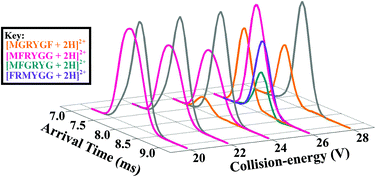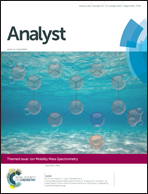Collision-energy resolved ion mobility characterization of isomeric mixtures†
Abstract
Existing instrumental resolving power limitations in ion mobility spectrometry (IMS) often restrict adequate characterization of unresolved or co-eluting chemical isomers. Recently, we introduced a novel chemometric deconvolution approach that utilized post-IM collision-induced dissociation (CID) mass spectrometry (MS) data to extract “pure” IM profiles and construct CID mass spectra of individual components from a mixture containing two IM-overlapped components [J. Am. Soc. Mass Spectrom., 2012, 23, 1873–1884]. In this manuscript we extend the capabilities of the IM-MS deconvolution methodology and demonstrate the utility of energy resolved IM deconvolution for successful characterization of ternary and quaternary isomer mixtures with overlapping IM profiles. Furthermore, we show that the success of IM-MS deconvolution is a collision-energy dependent process where different isomers can be identified at various ion fragmentation collision-energies. Details on how to identify a single collision-energy or suitable collision-energy ranges for successful characterization of isomer mixtures are discussed. To confirm the validity of the proposed approach, deconvoluted IM and MS spectra from IM overlapped analyte mixtures are compared to IM and MS data from individually run mixture components. Criteria for “successful” deconvolution of overlapping IM profiles and extraction of their corresponding pure mass spectra are discussed.

- This article is part of the themed collection: Ion Mobility Mass Spectrometry

 Please wait while we load your content...
Please wait while we load your content...